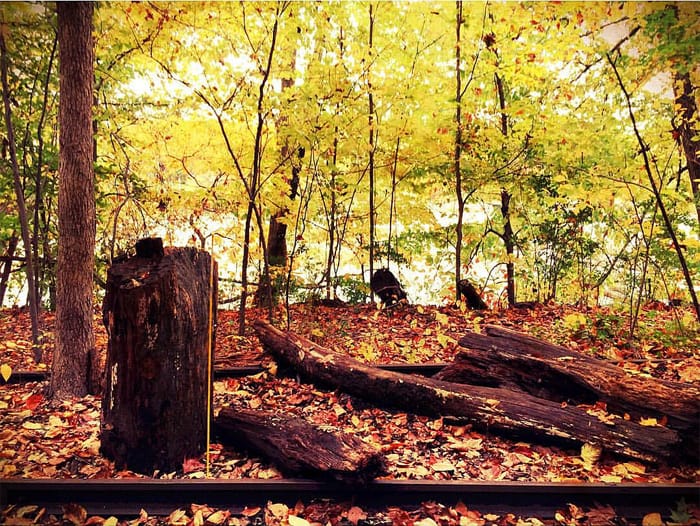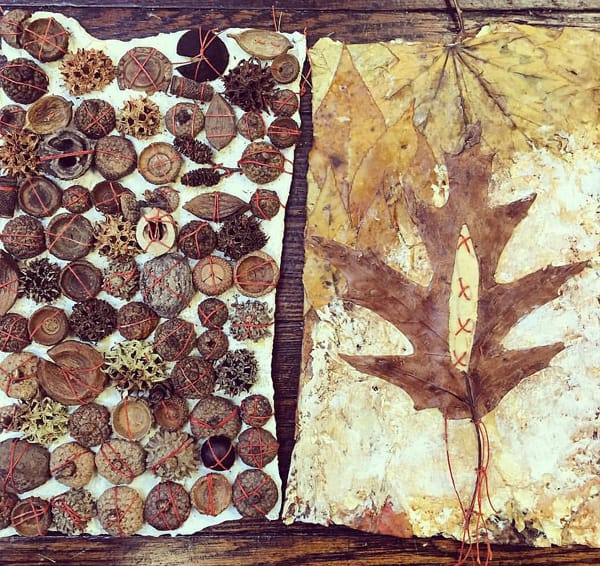This month I have been working steadily on my artist books for the outdoor installation at Lake Roland Park for their Art on the Trail Program. It was just this week that things started to fall into place and I am excited about the progress. About two weeks ago I went to the park to walk the trail with a few of the other artists who were also accepted to claim our sites. The photo below shows my site that I picked out. The tall stump will be the perfect lectern for my mossy book to sit on.
The title of my installation is “Field Guides” and below is my artist statement that will be printed on a sign on the trail by the site.
“Field guides and trail maps are used to research and plan trips in the outdoors. These book art pieces were created using natural materials gathered from the park and nearby areas to speak to the idea that the natural materials in our environment actually hold information and history of the life around us. As a modern society behind computer screens and time spent indoors, we are losing the ability to read that information. The artist invites viewers to create a closer relationship to Earth and enhance their ability to use elements of nature as field guides and maps to both the past and future.”
I have made several pages of one book already, below are two pages, still yet to be bound:
One of my books is entirely made of moss. I have stitched a compass on top of the moss. When I was in Alaska hiking one of the trails with a guide, he said that there’s an old wives tale that if you’re lost in the woods, you can look at where moss is growing and that can tell you what direction north is. If you’ve ever been in a temperate rain forest in the pacific northwest you will immediately note that you will stay lost if you’re using that as a guide! Moss grows everywhere. But it’s an interesting tale to keep in mind and it makes sense why one would think that as the north side of trees and buildings stay in the shade for longer amounts of time. I read somewhere that moss doesn’t care about north or south, but in certain circumstances it could possibly help you figure out orientation. It really is best to carry a compass or at least to be able to read the sun’s position in the sky. But the sun can be hidden, so again really, best to have a compass and a trail map. I stitched my loose interpretation of the trail map that is used for Lake Roland Park on one of my moss pages. Moss has been so useful to humans since the very beginnings- as wound dressing, diapers for babies, insulation against the cold, and bedding.
I have been reading up a lot on trees and moss and plants- their history and mythology and meaning to humans throughout time. Fascinating.
There is still a lot of work ahead, but I am happy with the progress and I am thoroughly enjoying the process. I will be really thinking on how I will be attaching the books to the fallen logs too to hinder theft. I have a couple of ideas. I am good with nature taking its course on the books. All of my materials are from the earth and will return to it at some point. But I am not ok with people taking it! Such is the risk though. We shall see. If you have any ideas, I’m open to hearing them. I am allowed to nail into the fallen logs and stumps.
“Much of our use of tees is hidden, in the sense that it is taken for granted, or not realized, hence the idea of the ‘hidden history.’ In many cases there is a continuity between the past and the present…” – Noel Kingsbury




Bridgette,
Oh, man, I wish I could see this in person. I love the idea of the field guides. Just watched the village tree guys take down a diseased oak tree across the street from our house that was planted sometime in the 1920’s. All I could think of was, “so much history this tree has seen.” Everytime I take a walk lately and see the white bullseye that signals a diseased tree, my heart tears a little. You must be so excited about this project. Good luck in the days ahead!
Hi Mary! It’s always so sad when an old tree has to come down, isn’t it? I’ve been reading some really interesting things about man’s connection to trees that i find fascinating and I bet you would too. I just read something about birch trees in particular- several cultures held birch trees in high regard. For instance- its bark was used for recording sacred texts in vedic times and in sanskrit the word for birch is bhurj. Also Slavs connected the word birch to the verb “to keep, to take care of” and viewed the trees as protecting people. I love learning this stuff!
Bridgette, absolutely love the compass on the moss. Can’t wait to see the other pages unfold. Quite a dilemma on how to attach the book.
Oh my goodness, I want to dive into that soft moss. Luscious.
This is so very exciting.
Oh my gosh, I LOVE what you’re doing here! What a wonderful installation you will have. I can’t wait to see more and wish I could see it in person!
What an incredible opportunity to be part of such a unique and special exhibition. What you have created so far is just perfect.
I too wish I could walk this trail. I love, yes, your moss book, (I can actually smell it as I write) which is so redolent of folklore, the passing of time, stillness thus motion (you have to move about a lot not to gather moss as the saying goes!) and I also like the little bound objects in your other work. I have been making little Plaster of Paris books and works according to your recipe in ‘Encaustic Revelation’. The book is getting dog-eared. The best thing to do to stop your book from being stolen is to place a nice curse on it. 🙂